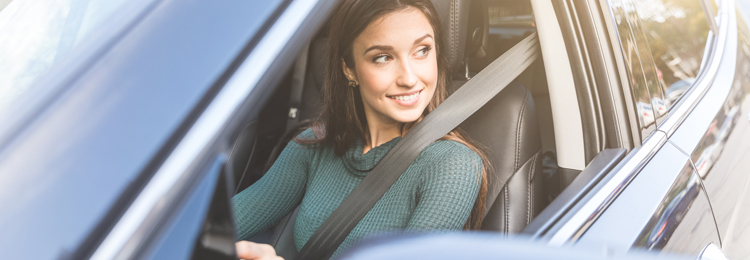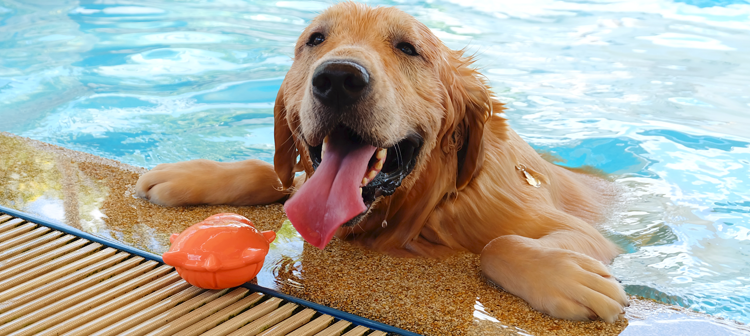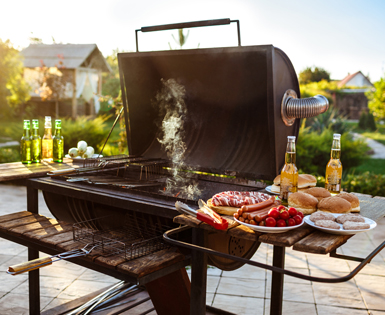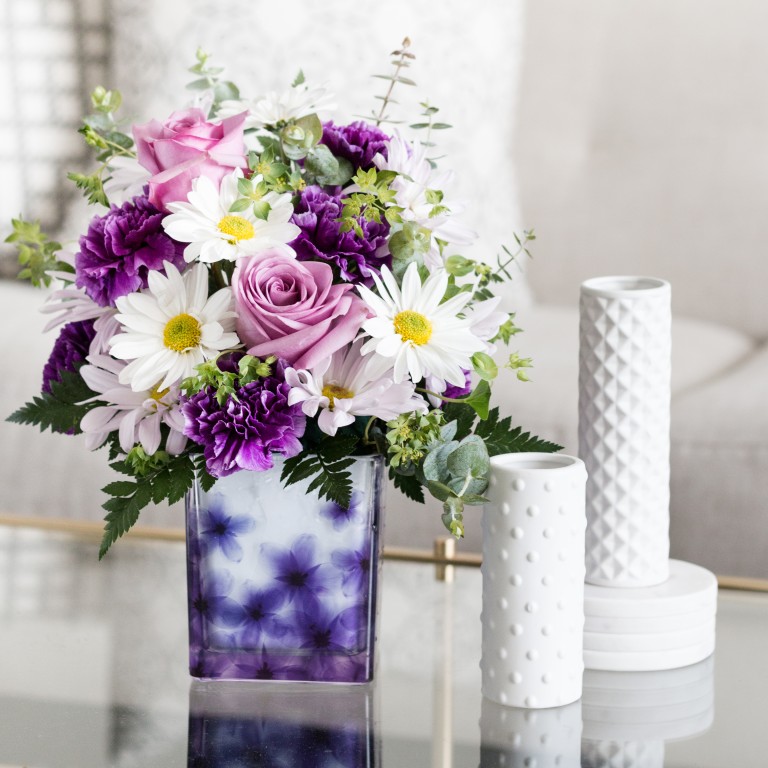Find consumer tips on everything from credit to home safety to travelling on a budget and so much more!
Make Back-to-School Better with Budget
Moving the kids to school is never easy. Advance planning, including reserving a rental truck, is key to making the move easier. Budget Truck Rental offers these simple guidelines to help make the back-to-school move more efficient, less stressful and safer:
- Pack like a pro. Students today are taking more than clothes and school supplies to campus; they're packing computers, printers, gaming systems and other electronics. Budget Truck Rental encourages customers to pack electronics in their original boxes, if available. If not, a strong box should be used and the components should be generously wrapped with plastic cushioning wrap. Packing peanuts or any shredded materials can get into the device and cause damage. Use caution with larger televisions. Many newer TVs need to be transported standing up or they could be damaged. The screen should also be protected. Whether boxes are filled with hangers, power strips/surge protectors, extra-long sheets or shower necessities, they should always be full. If there is space at the top and the box is already heavy, some light weight filler like plastic cushioning wrap, packing peanuts or crumpled paper should be added. Otherwise, if there is empty space at the top, stacking on top will cause the box to crush and tilt. Boxes should be labeled on the sides, not the tops, which may be covered by other boxes. In addition, Budget Truck Rental offers a wide variety of products to make moving easier. These include furniture pads and dollies, boxes, tape, plastic cushioning wrap and rope.
- Plan your truck needs ahead of time. To ensure truck availability, reservations should be made as far in advance as possible. Truck availability is best mid-week (Sunday through Thursday) and mid-month. Hand trucks and moving pads can help make moving easier and protect possessions. Budget Truck Rental locations have these available for rent.
- Plan your travel route. Trucks are prohibited on some roads. Budget Truck Rental recommends planning the proper route ahead of time to avoid police citations for driving on roads where trucks are prohibited or getting stuck beneath an overpass. Budget Truck Rental is the first and only major consumer truck rental company to offer Global Positioning System (GPS) units that include routes designated for trucks. With guidance by Garmin® , where2 offers Budget Truck Rental customers an array of navigation features, including truck routes and local points of interest such as ATMs, hotels, restaurants and gas stations, a simple user interface, high-quality maps, audible turn-by-turn directions spoken in multiple languages and Bluetooth hands-free calling capability.
- Drive safely. Customers should take time to adjust the rental truck's mirrors. Caution should be used when backing up the truck and renters should never back up with towing equipment. Budget Truck Rental recommends that customers use extra caution on sharp turns. Trucks are longer and wider and need more turning area than cars. Renters should always use the turn signal and allow greater distance (at least five vehicle lengths) between the truck and the vehicle ahead. Customers should watch for overhead clearances, allow for at least 14 feet of overhead clearance, and beware of low canopies, overpasses, bridges, drive-through lanes, tree branches, parking garages and signs prohibiting truck traffic.
Budget Truck Rental's fleet features cargo vans, 10-foot, 16-foot and 24-foot trucks with ramps or lift gates and is one of the cleanest and best-maintained rental truck fleets on the road. Every vehicle undergoes a 10-point quality inspection to ensure proper fluid levels, tire pressure and other necessary elements for a reliable, safe rental. All Budget trucks feature automatic transmissions and have free 24/7 emergency roadside assistance.

*Adapted from Budgetruckcom website.

The start of a new school year can be challenging for students and parents alike. Tuition, making new friends and hitting the books are just a few of the tests you have to face. Getting there does not have to be one of them and it doesn't have to cost an arm and a leg.
Home Repairs and Updates That Will Help Your Home Sell
Do Some Yardwork, First Impressions Count
- Keep the lawn moved, preferably on the diagonal
- The color yellow sells – plant yellow flowers such as marigolds along the walkway or by the front door
- Wash the exterior windows
- Paint or replace the front door and buy new hardware
- Power spray the house to get rid of dirt and cobwebs
- Buy a new welcome mat for the front steps
- Paint or replace the mailbox
Declutter Your Home
- Remove all personal photographs from the tables and walls. Patch holes in the walls or hang non-personalized artwork over the existing nails
- Pack up your bookcase (you’re going to move anyway)
- Clean out the closets and store non-essential items
Clean, Clean, Clean…Your Kitchen
- If new granite is out of your budget, consider either re-grouting the kitchen counter tiles, which is surprisingly cost effective, or covering them with granite tiles instead of granite slab
- For wood cabinets, stripping the finish and re-staining or painting will save you more money than re-surfacing the cabinets
- Buy new knobs and/or pulls for the cabinet doors.
- Replace a worn kitchen faucet
- Buy a new kitchen sink basket strainers
- Consider installing kitchen pendant lights over the sink
With these quick and budget-friendly tips, you’ll be on your way to maximizing the value of your home and one step closer to the closing table.
If you are ready to sell your home, don't forget the Union Plus Real Estate Rewards program. You can earn $500 cash back for every $100,000 in home value when you use a real estate agent, approved by SIRVA.

*Certain state restrictions apply to the real estate cash back program. To qualify for cash back rewards (in cash back states), you must use a SIRVA-referred real estate agent. Program designed as a referral service to provide you the opportunity to select a real estate agent to meet your needs. You must evaluate the brokers, agents and their services and make selections and decisions based upon your best judgment, interest, priorities and concerns. Call 800-284-9756 or visit www.up-RealEstateRewards.com for important program details and state restrictions.
SIRVA is an independent provider of services. Union Plus is not affiliated with SIRVA and does not manage SIRVA or its programs. SIRVA is paying Union Plus for advertising services including dissemination of information about SIRVA and its programs to participating unions and their members as well as participation in Union Plus events and programs. No referral, recommendation, service representation or exclusivity requirement is intended by the Union Plus's mention or dissemination of the SIRVA name and delivery of this information to participating union members.

It’s always nice to actually make money when selling your home, but you might not be in the position to spend a lot of money making updates to your home before you sell. There are however, many things you can do that are relatively inexpensive that could make a big difference in the sale price of your home. Here are some cheap and easy tips for how you can spruce up your home and get top dollar at the closing table.
Three Counterintuitive Ways to Save Money
Shop for Groceries More Often
Common sense seems to dictate that the less shopping you do, the more money you save. While that may be true in most instances, it may not be the case for you, especially if you’re not great at setting a schedule and sticking to it. If you have an issue wasting food (which is statistically probable, given that nearly one-third all food produced in the world ends up going to waste), long-term grocery planning may not be your strong suit. And that’s fine! I personally find that when I try to plan meals out for an entire week, things inevitably go awry and something goes to waste. So instead, I tend to shop in four day cycles. This makes it easier to invest in fresh produce and helps ensure I use up everything I bought.
Invest in Quality
When you’re trying to save money, the less expensive option will always look the most appealing. Cheaper, older, secondhand – however you get there, if it costs less, it will almost always jump to the head of the line.
But cheaper rarely means better, and a dollar saved today could cost you five times over in the future. That’s why spending more for higher quality can often be such a worthwhile, money-saving investment. From mattresses to dress shoes, when you invest in high quality goods, it can save you money in the long run. You can and should still be choosey, of course. Do plenty of research and price comparison before making your selection.
Plan to Splurge
Unplanned expenses can be budget-busters, and unplanned splurges can be even more damaging. When you’re living on a tight budget or trying to save money, you may feel routinely tempted to break from your frugal lifestyle and splurge. That’s natural – the more constricted your spending is, the more you’re going to feel that desire to buy something.
Rather than running away from those urges, consider working them into your spending plan. In much the same way that athletes on a strict diet allow themselves to have a “cheat day”, you can build a planned splurge into your budget. You don’t have to plan out your purchase, just leave a space in your budget – once a month or once a paycheck – and use those funds to “cheat”. By having your splurge planned out, you scratch that itch, but you’re prepared for it and your budget is designed to support it.
Union Plus Credit Counseling
Union members can get a no-obligation money and credit assessment from certified, experienced consumer credit counselors though Union Plus Credit Counseling. Powered by the non-profit Money Management International (MMI), your free session will cover a complete financial review, assistance in budgeting, advice for working with creditors, and more.

There are plenty of good ways to save money, many of them pretty obvious. Get rid of cable TV; eat out less; turn off the lights when you’re not in the room, etc. There are also a few slightly less obvious ways to save – ways that may even seem a little backwards at first glance.
Outdoor Patio Decorating Tips for Summer
Bring People Together
Make your patio a popular spot for family and friends to gather by equipping it with comfortable, intimate seating arrangements. If your clan enjoys gathering around a delicious grilled dinner, consider investing in an outdoor dining table with plenty of chairs. If the patio is situated in a particularly sunny spot, choose a table with a detachable umbrella that can block your loved ones – and their meals – from glaring rays.
While you may not want to use your finest china for your outdoor eating space, you don’t need to settle for paper plates. Discount stores and online shops offer plenty of durable, affordable table settings in cute designs for every aesthetic. Because patio dinners are more likely to involve spills and accidents, select dinnerware made from plastic and metal instead of glass.
Plan on hosting more casual get-togethers? Plush outdoor couches and chairs are perfect for relaxing in the great outdoors. To enable your patio to transition from day to night, install a fire pit or invest in heat lamps.
Light It Up
Go ahead and bring a little ambiance to your space by adding soft lighting. Twinkle lights, tiki torches and lantern-style lights are all excellent options, as they provide a glow without being too harsh or overwhelming. When hosting nighttime celebrations, consider creating a path from the house to the patio using lawn lights. Guests won’t be stumbling around in the dark, and your mood lighting won’t be compromised.
Add a Natural Touch
You choose to spend time on your patio rather than in your living room because it’s outside, so don’t clutter it with indoor decor. Instead, decorate it with nature’s embellishments: flowers and other eye-catching plants. Want your patio to be a Zen paradise? Bring in some potted greenery, like succulents or bamboo. Searching for the perfect centerpieces for summer barbecues? Roses, lilies and sunflowers are the best summer flowers to put the finishing touches to any warm weather dinner table.
It only takes a few additions to a backyard patio to make it the perfect escape. In addition to all of these tips, make sure you know what plants help keep the mosquitos away!


Your back patio is a great space for cooking out, relaxing, dining, playing and entertaining. With so many uses, finding the right balance between functional and fabulous in your patio decor can be a difficult task. Need some inspiration for sprucing up your multipurpose outdoor space? Check out these patio decorating tips from Teleflora for creating a welcoming and beautiful space for summer.
Today’s Drivers. Tomorrow’s Features.
Safety is often cited as a top priority among car buyers and rightfully so, considering automotive fatalities have increased in recent years and continue to result in over 30,000 deaths per year. To date, automotive fatalities are the number one cause of accidental deaths in the USA. As grim as those truths are, there is a bright side. Automakers continue to develop technologies that minimize danger to drivers, occupants and pedestrians every year. In fact, the National Highway Transportation & Safety Agency (NHTSA) is exploring changes to the New Car Assessment Program (Star Ratings) to address the rapid developments in vehicle technology, especially in the area of crash avoidance.
As safety technology improves, it means that new vehicles today often have more safety equipment than the most advanced vehicles from 10 years ago.
Overwhelmed or confused about what safety systems are out there and how they work? We’ve put together a list of key safety technologies for you to consider during your next vehicle purchase.
Blind Spot Monitor
We love Blind Spot Monitor systems because the technology is remarkably easy to use, and something we interact with nearly every time we get behind the wheel. When another vehicle is traveling alongside you and is a bit too close for comfort, a notification light will turn on letting you know that it’s unsafe to change lanes. These notifications are often found on the side view mirrors, but we prefer applications where the warning lamps are on the inside of the car within the line of sight of the mirror. This eliminates any obstruction due to moisture, dirt or snow. Some automakers are now including notifications in the Heads Up Display that projects onto your windshield, so a driver doesn’t even need to turn his/her head to know if a vehicle is in the blind spot.
Automatic Emergency Braking (AEB)
AEB combines multiple technologies to minimize or eliminate collisions. While the technology was first used in applications for vehicles traveling forward, the technology has been applied to prevent crashes while traveling backwards. Sensors in the vehicle calculate vehicle speed against required stopping distance and applies the brake when a collision is imminent or likely. The system alerts the driver, pre-charges the brakes and, if necessary, automatically applies the brakes in rapid succession. Often, AEB works with seatbelt pretensioners that retract the seatbelt, holding occupants snugly in place to reduce injuries that may occur from a collision. Many automotive safety experts believe that AEB is the single most valuable technology available today to reduce the traffic accidents on the road.
Surround View Cameras
Starting in 2018, all new vehicles in the US will be mandated to come equipped with a rear-view camera. This is in response to an incident in 2002 where a child was tragically killed when a driver was unable to see them as they backed out of a driveway. While danger of injury to pedestrians located on the side or in front of the car is less likely, surround view monitors provide a 360 degree, overhead view of the area surrounding your vehicle. This helps keep your car safe too, reducing the likelihood of dents and scrapes while negotiating tight parking spots or alleyways.
Lane Keep Assist
While fully self-driving vehicles are still years away, we can already enjoy the benefits of this emerging technology today. Semi-autonomous driving systems use sophisticated sensors to detect traffic lanes and vehicle surroundings. These sensors enable the vehicle to control speed, distance between vehicles and steer within a lane. Some vehicles now offer the ability to change lanes automatically as well. These systems are not designed to completely take over control of the vehicle, and require consistent monitoring from the driver (or the system will shut off). While the systems don’t allow for drivers to be inattentive, they help reduce driver fatigue over long hauls and assist the driver in maintaining awareness of driving conditions.
Lane Departure Warning
A step below Lane Keep Assist systems is Lane Departure Warnings. While these systems don’t actively steer the vehicle, they detect traffic lanes and alert the driver to any drifting outside of those lanes. The alerts vary from audible chimes, to visual cues, to haptic seat feedback, to a slight nudge from the steering wheel to get you back on track.
Cross Traffic Alert
Nearly every driver has experienced pulling out of a driveway or parking spot at the mall and had their heart skip a beat as a car goes whizzing by. Rear Cross Traffic Alert systems act as a spotter to oncoming traffic that can be difficult or impossible to see. The system is often integrated with rear camera monitors and can also indicate which direction the traffic is coming from. The haptic seat feedback systems that give your seat a buzz rather than audible chimes assure only the driver is alerted.
Driver Awareness / Heads Up Display / Voice Recognition
We are bundling a variety of emerging technologies into a category that minimizes driver distractions. Heads up displays project an image onto the windshield, just above the steering wheel, in a driver’s line of sight and provide a snapshot of relevant data like vehicle speed and navigation instructions. Voice recognition allows for common functions like temperature settings and audio playback. And driver awareness monitors driver inputs from the steering wheel and throttle; in some cases, it watches your eyes to detect drowsiness or lack of attention. These features are designed to make sure your eyes stay on the road, your hands stay on the wheel, and your attention stays focused on arriving to your destination safely.
SOS Services
If an accident occurs, many vehicles now offer post-accident emergency services to automatically dial 911 and send help. These telematics systems may require a cell phone to be paired to your vehicle or a subscription to an automaker supplied service, so be sure to talk to your local TrueCar dealer to ensure that you are set up to take advantage of all the safety systems available on your vehicle.
Rear Seat Occupant Warning (GM)
In 2014, over 30 children died from heatstroke after being left in a vehicle. In an effort to prevent further tragedies, General Motors introduced a feature that would alert the driver with an audible alarm, typically using the horn to notify the driver that they may have left an item in the rear seat of the vehicle. The technology uses a simple logic to perform this check. If a driver opens a rear door, enters the driver’s seat, exists the vehicle and doesn’t open the rear door again, the vehicle will trigger an audible alert.


See which car features are most notable for the current market.
Two Summer Water-Related Hazards for Pets
Water Safety
Although many canines are strong swimmers, they should always be closely supervised and wear life jackets when their owners take them for a summer swim.
Pet owners with pools should pay close attention to outdoor cats and dogs when they’re playing near the pool in case they accidentally fall in.
“For dog owners with pools, I always suggest training their dogs to find the shallow end of the pool or the stairs so they can exit the pool safely. This is important regardless of whether you plan to let your dogs swim in the pool. I recall a claim we processed for BooBoo, an English bulldog, who was found unconscious on the pool floor; but thankfully he recovered after an emergency visit to the veterinarian,” said Dr. Stephens, founder of Pets Best. “Even dogs that are good swimmers or wearing life jackets can tire quickly and be put in danger if they can’t find their way out of the pool.”
A few other bodies of water hazards pet owners should be aware of include:
-
Exposure to Leptospira, a potentially deadly pathogen found within some lakes and ponds.
-
Fishhooks, which can get stuck in paws if stepped on, stuck in mouths, or even swallowed.
-
Boats, they can accidentally hit dogs who are swimming in lakes.
Ear Infections
Ear infections are one of the top five most common dog insurance claims we process at Pets Best. Ear infections are an especially common summertime ailment among dogs that swim frequently. These infections are often caused by water entering dogs’ ears while swimming. Pet owners can help prevent this by utilizing an ear cleanser prescribed by a veterinarian to clean and dry a dog’s ears after swimming.
We hope you and your pets enjoy safe and healthy water adventures this summer.


Playing in the water is a great way to cool off for both humans and our pets. But when it comes to dogs and cats, water can present some health issues and hazards as well. Keep your pets safe with these tips from Pets Best, the nationwide dog and cat health insurance agency that powers the Union Plus Pet Health Insurance program.
Top Ten Summer Road Trip Tips
-
Tend to your tires.
Check your tire pressure - and check it often. Also, make sure that you have season-appropriate tires on your car. Use your union member Union Plus Goodyear Coupon for car tune-ups and new tires, including union-made tires. -
Stay on top of your fluids.
Oil and coolant are the two key fluids during the summer months to keep your car cool and running smoothly. And in the winter, anti-freeze is a key fluid to monitor. -
Give the rest of your car a once-over.
Check the battery, belts, and hoses or have a mechanic do so before you head off on that cross country trip. Also, make sure your wipers are ready and don't forget your windshield wiper fluid. -
Prepare an emergency kit for your car.
Keep the number of Union Plus Motor Club - 24 Hour Emergency Automotive Roadside Assistance Plan handy. -
Pack smart.
Keep snacks, drinks, and sandwiches handy. -
Load smart.
Don't block your view with a backseat piled high and keep the weight even for maximum handling. -
Stay awake.
Switch drivers every few hours even if you don't think you are tired. -
Be careful when you tow.
Check your owner's manual to make sure your vehicle is properly equipped to handle a trailer hitch for towing campers or trailers, and that it can handle the weight. -
Take the scenic route.
Give yourself time to enjoy the ride. -
Be nice.
Use your signals. Let faster drivers pass. Don't tailgate. Share: it's not your road.

Planning a road trip this summer? Before you hit the road, make sure you check out these top 10 tips to ensure your travel is safe, fun and stress-free!


How to Tell When a Grilled Steak Is Done
As a trained chef, I've learned to embrace the barrage of culinary queries from friends and family. “Can I swap out curly parsley if I can’t find Italian flat-leaf?” “What’s the easiest way to chop an onion?” And so on. But the question chefs probably hear the most—and have the hardest time answering—is how to know when a steak is done.
It can be difficult to explain because the real trick is cooking enough steaks to develop a sixth sense for internal temperature. Absent the intuition that comes from years of practice, a meat thermometer is the way to go—both for food safety and to ensure you don’t overcook a pricey prime porterhouse.
Some people think using a thermometer when grilling is a cheat, or maybe they had bad experiences in the past with older, leave-in analog meat thermometers, which routinely do poorly in CR's tests. But using a digital meat thermometer is the best way to make sure the meat is cooked to a safe internal temperature.
The Hand Method
One of the most popular methods of determining whether a steak is done is something called the hand method, a decidedly unscientific touch test that calls for holding one hand palm up and using the index finger of the opposite hand to press the ball joint below your thumb. So the thinking goes, that squishy feeling is how the center of a steak should feel when it's rare.
Making a pincer grip with your thumb and index finger—causing the joint to tense slightly—is how a steak should feel at medium rare. The same motion repeated with the middle, ring, and pinky fingers represent medium, medium-well, and well-done, respectively, or so the lore goes.
To see whether there's any validity to the idea, Consumer Reports put the hand method to the test. We used the Weber Genesis E-410, $900, a model we chose for its perfectly even heating in our gas grill tests.
We then grilled five sirloin steaks. The steaks were all cut to the same thickness, and we grilled them one-by-one at the same temperature. For reference, we cross-checked the temperatures with our top-rated Oregon Scientific Wireless BBQ/Oven AW131 meat thermometer, $40, and logged the final temperature before cutting in to see how the steak looked.
Here's how it all turned out.
How We Tested the Hand Method
Like the USDA, Consumer Reports recommends cooking whole cuts of beef to a minimum internal temperature of 145° F. "With steaks, any bacteria present is likely to be on the surface of the meat and 145° F is hot enough to kill those bacteria," says James E. Rogers, Ph.D., director of food safety and testing at Consumer Reports.
In our hand method test, we checked the steaks at every stage from rare to well-done and compared the results to widely recommended internal temperatures from outside sources.
Rare
- Target temperature: 125° F
- Temperature with hand method: 106° F
Did it work? No. While Consumer Reports never recommends cooking steak rare, the hand method posed an extra risk here, as it caused our test steak to come in a full 19° F below the already risky internal temperature of 125° F.
Medium-Rare
- Target temperature: 135° F
- Temperature with hand method: 110° F
Did it work? No. Again, the hand method yielded a result that would be well below what most would consider medium-rare. Cutting into the steak revealed a thin red band and saturated pink meat throughout, and was pretty consistent with a steak we'd consider rare.
Medium
- Target temperature: 145° F
- Temperature with hand method: 127° F
Did it work? No. Medium steaks are among the hardest to master because medium means something different to almost everyone. Again, the hand method yielded an undercooked steak. The thermometer told a different story. Despite looking like a steak cooked medium, it was still 18° F below a temperature we'd consider safe.
Medium-Well
- Target temperature: 155° F
- Temperature with hand method: 142° F
Did it work? No. For our medium-well steaks, we also found the hand method lacking. We got a steak most people would call medium, and according to the thermometer, it was still 3° F shy of the minimum safe temperature recommended by the USDA.
Well-Done
- Target temperature: 165° F
- Temperature with hand method: 157° F
Did it Work? No. Cooking a steak well-done sounds easy enough, but the line between eliminating any traces of pink and overcooking the meat is a fine one. Once again, the hand method produced a result that was a bit on the undercooked side. That can be off-putting if you prefer a steak with no traces of pink.
The Verdict
The hand method receives a thumbs-down. Although the steaks in our test did firm up as internal temperatures rose, the meat thermometer consistently told a different story. That proved our long-held advice that you can't depend on the color of cooked beef to judge the temperature.
In a pinch, the hand method could help you avoid overcooking a steak, but it should never be a stand-in for ensuring steak is safely cooked. A better idea? Use a thermometer to note the temperature of a steak you consider perfectly cooked, and you'll be able to replicate the result all summer long.

Copyright© 2006-2017 Consumers Union of U.S., Inc. No reproduction, in whole or part, without written permission.

Consumer Reports tests the "Hand Method" to determine if a steak is done. You might be surprised how it turned out!
Introducing Financial Literacy to Children
Unfortunately, for a lot of folks, these lessons come later than they should, and often as the result of something going terribly wrong. Not enough people make financial education a priority for children, which results in young adults entering a surprisingly complex financial world without the tools necessary to survive and thrive.
Even if your children are very young, remember that the sooner you start teaching them money and personal finance skills, the more apt they’ll be at applying those skills when the time comes.
Check Your Attitude
One of the most difficult issues parents have to face is step one – examining your own attitudes about money. This is extremely important because your children learn more from what they see you do than from what you tell them. You can preach to your kids every day that “A penny saved is a penny earned,” or that “A fool and his money are soon parted,” but it won’t do any good if they see that you waste your own money consistently.
Be an Open Book
It is very important to communicate openly with young kids about money, in simple terms that they can comprehend. Too often, young adults have to learn about credit and debt the hard way: by fending for themselves. It’s better that they learn about personal finances under the guidance and tutelage of someone who’s already been there – their parents.
Involve Children in Family Financial Planning
While a young child won’t necessarily understand or appreciate the finer details of budgeting and investing, it can be very helpful to keep them informed of the broad strokes of your family’s financial plan. If you can help them understand that money isn’t limitless and that careful planning is needed for all major (and many minor) spending decisions, that can go a long way towards positively shaping their understanding of personal finance.
Give Children a Chance to Be in Control
If you give your child an allowance, let them be in charge of spending it. This is a great way to teach the relationship between their actions and the positive or negative consequences that follow. The key, of course, is to talk about their choices and help them understand why money spent today isn’t available tomorrow. You can also open a savings account in their name and let them make deposits, so they can see the value in building savings.
Provide Extra Income Opportunities
Allowance is nice, but it’s helpful to show children that money is something you earn, not something you are entitled to. Considering offering children opportunities to earn money, rather than just handing it out. This is also a great way to show them the value of hard work and hand off a few of the less unenjoyable household chores.
Take Children Shopping With You
You can use routine shopping trips as an opportunity to give children a sense of scale when it comes to money, showing them that some things are more expensive than other things. You can also explain to them why you buy the things you do. By showing them the details you take into consideration, you’ll be teaching them how to be a more mindful consumer.
Union Plus Credit Counseling
Union members can get a no-obligation money and credit assessment from certified, experienced consumer credit counselors though Union Plus Credit Counseling. Powered by the non-profit Money Management International (MMI), your free session will cover a complete financial review, assistance in budgeting, advice for working with creditors, and more.

Understanding how money works is an essential life skill, and knowing how to make your money work for you is just as important. So when do you learn these crucial life skills?
Floral Cocktails Perfect for Summer
Aviation
The aviation cocktail was first crafted in New York City at the turn of the 19th century. It gets its tangy, botanic flavor from creme de violette and gin. To make this drink according to Honestly Yum’s recipe, you’ll need:
- 1 edible violet
- 2 ounces gin
- 3/4 ounce lemon juice
- 1/2 ounce maraschino liqueur
- 1/4 ounce creme de violette
Fill a cocktail shaker with ice, then add all the liquid ingredients. Shake everything together for about 10 seconds, strain the drink into your serving glass of choice and garnish with the edible violet. Invite your friends over for some aviations and decorate using Teleflora’s Dancing Violets Bouquet.
Rose Margarita
For a floral take on classic summer favorite, look no further than the rose margarita. This cocktail, created by mixologist Junior Merino for Paste magazine, uses rose petals and rose syrup to give the traditional marg a seasonal upgrade. Make your own by grabbing the following ingredients:
- 1 1/2 ounces blanco tequila
- 1 ounce fresh-squeezed lime juice
- 3/4 ounce rose syrup
- 3/4 ounce orange liqueur
- Hibiscus and rose salt
- 3 organic rose petals.
To begin, prepare your margarita glass by rimming it with hibiscus and rose salt. Combine the liquid ingredients and the rose petals in a cocktail shaker filled with ice. Shake until all the ingredients are well-mixed, pour into your rimmed glass and garnish with additional petals. This drink pairs beautifully with Teleflora’s Rose Rapture Bouquet.
Bachelor’s Button Martini
As light as a feather and as frothy as a cloud, the Bachelor’s Button Martini is the perfect cocktail to nurse on a hot summer night. Assemble the following ingredients to make Anthropologie’s favorite version of this airy, floral delight:
For the cocktail:
- 2 ounces gin
- 1 ounce lemon juice
- 1 egg white
- 1 1/2 ounces Lillet Blanc
- 1/4 ounce bachelor’s button simple syrup
- carnation and bachelor’s button petals.
- For the bachelor’s button simple syrup:
- 1/4 cup bachelor’s button petals
- 1 1/2 cups sugar
- 1 cup water.
To craft this cocktail, begin by mixing the bachelor’s button syrup. To do so, add the bachelor’s button petals, sugar and water to a saucepan over medium heat. Stir the ingredients together as you bring the syrup to a boil and allow it to simmer. Once the sugar has dissolved completely, turn the heat down to low and cook the mixture for an additional 15 minutes. Once the syrup is cool, strain it into a cocktail shaker filled with ice. Add the gin, lemon juice, egg white and Lillet Blanc. Shake for about 30 seconds, or until the cocktail becomes frothy and foamy. Pour the drink into a martini glass, adorn with extra petals and start sipping. For the full floral experience, imbibe these martinis alongside Teleflora’s Garden Delights arrangement.
Let us know your favorite combination below! These are only a few of our favorite summer flowers and drinks, so let your creativity take over a create one of your own. There are so many different edible flowers that you can use to create your very own summer signature meal and floral cocktail!

There’s no time like summer to experiment with fresh floral cocktails. Flower-infused alcoholic beverages have become all the rage over the past few years, and they make the perfect addition to any warm weather celebration. Light, crisp and colorful, these concoctions are perfect for sipping under the sun. This season, impress your party guests with one of these tasty floral cocktails from Teleflora's blog, inspired by Teleflora’s favorite summer flowers:


